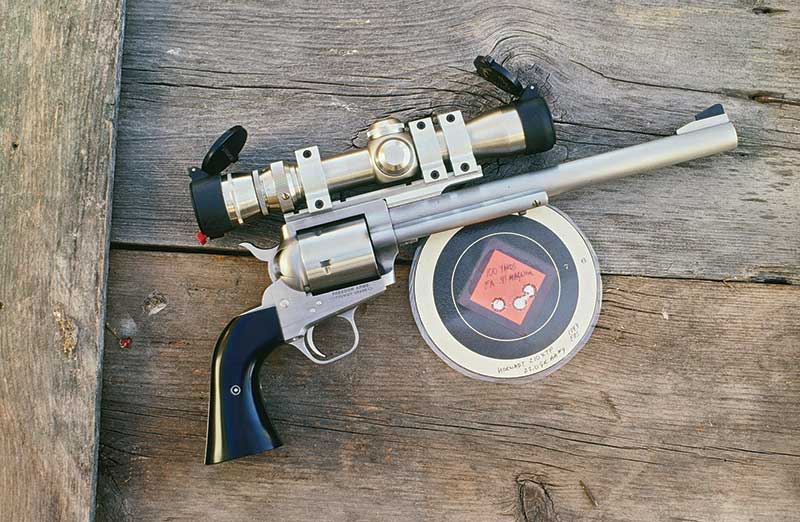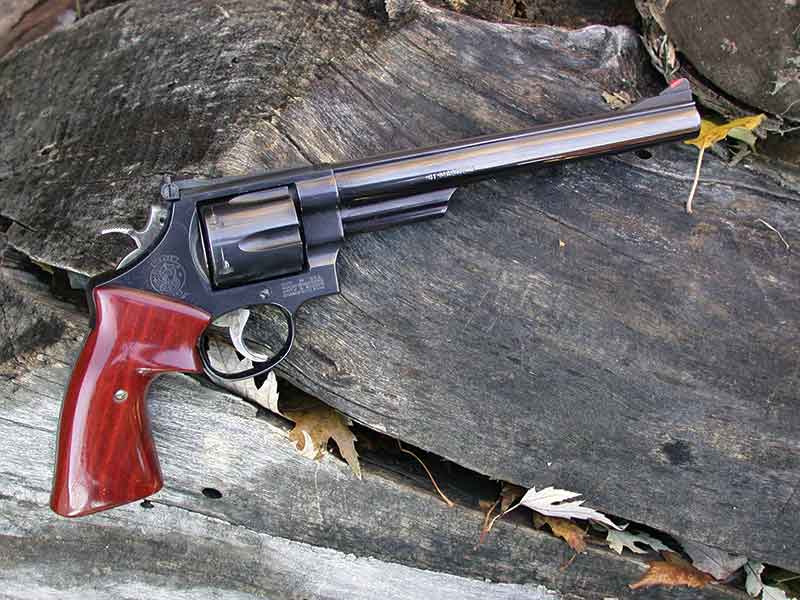Hail The .41 Magnum
The “Redheaded Stepchild” Turns 50
Sometimes things just don’t happen the way they should. The .38 Special, an improvement on the shorter and slightly fatter .38 S&W, arrived around the turn of the 20th century and then 35 years later was lengthened to become the .357 Magnum. The .44 Magnum of 1955 is nothing more than a lengthened .44 Special which goes back to 1907 and was itself a lengthened .44 Russian of 1871. The Russian itself had been an improvement of the .44 S&W American of 1869.
Everything was done properly. And then came the .41 Magnum showing up like an orphan abandoned on a fire station doorstep. There was no .41 Special to lengthen to become the .41 Magnum so it has no ancestry, and instead of being offered in between the .357 and .44 as one would expect, S&W waited 8 years after the .44 Magnum before introducing its little brother. Acceptance varied greatly. There were those who thought it was the best sixgun cartridge ever and still do. Others said there was no need for it. Truth be told, it actually is an excellent sixgun cartridge in its own right.
Some of us tried to also give more credibility to the .41 Magnum by coming up with its ancestry after the fact. As far as I know Hamilton Bowen was the first to build a .41 Special and he did three for me nearly 25 years ago. One is a 5-1/2-inch Colt Single Action, another a 4-5/8-inch Ruger Flat-Top, and a 4-inch S&W Model 586. At first it was necessary to make brass by trimming .41 Magnum brass to .44 Special lengths, however, in recent times .41 Special brass properly headstamped has been offered and I have 500 brand-new rounds for reloading chores with this mild-wildcat cartridge. A former editor of Cartridges of the World asked my permission to use my loads in their section on the .41 Special and they are still in the current edition. Just as with the .357 Magnum and .44 Magnum, Specials work just fine in .41 Magnum sixguns.
S&W was the first company, naturally, to market a .41 Magnum sixgun. In his book, History of Smith & Wesson, Roy Jinks says, “The .41 Magnum was developed in 1963 to fire a cartridge between the .357 Magnum and .44 Magnum. When the cartridge was developed, Smith & Wesson manufactured a companion revolver to its famous Model 29. It was identical to the Model 29, except that it chambered the .41 Magnum caliber. The first serial number for the Model 57 was S277750 and the model was serial numbered with all other N-Frame revolvers … Although the Model 57 is a popular handgun with collectors and handgun hunters, it never had the reputation or fame of the Model 29 .44 Magnum. It was a cartridge that was needed to fill a gap, but for some unknown reason, this model never received the recognition it deserves.
The fixed sight Model 58 .41 Military & Police was introduced by Smith & Wesson to replace the discontinued .44 Special Military Model of 1950. The production of this handgun had been urged by such famous handgunners as Bill Jordan, Elmer Keith, and Skeeter Skelton, all of whom assured Smith & Wesson that it was the ideal handgun for law-enforcement agencies. The Model 58 was introduced on July 10, 1964, as the first fixed-sight revolver manufactured in this caliber. The first test gun in this caliber was built on the frame of a .38/44 Heavy Duty revolver … The Model 58 was developed primarily for law-enforcement use; therefore, when it was introduced, it was only manufactured with a 4-inch barrel having either a blue or nickel finish. Although it has had some acceptance by law enforcement, this revolver has not lived up to factory expectations or those of the individuals who help promote its manufacture.”
Elmer Keith in his autobiography, Hell, I Was There, shares his part in bringing the .41 Magnum to fruition working with Bill Jordan and the powers to be at Smith & Wesson and Remington: “I asked them for a .41 Magnum, case length to be the same as the .44 Magnum, bullet diameter to be .410 so that no old .38-40s or .41 Long Colts could ever be revamped to handle the larger bullet as they go around .403. I wanted a 220-grain bullet. Doug Hellstrom also insisted on the .410 diameter to preclude the possibility of a cartridge ever being used in the old .41 guns which would not take its pressures. Earl Larsen of Remington could make the ammunition if the other boys would make the guns. Doug Hellstrom and Bill Gunn of Smith & Wesson agreed to bring out the gun … Some six months later just as Charlie Shedd and I were leaving for the Arctic on our polar bear hunt, a pair of 4-inch Smith & Wesson Magnums, with target sights and triggers trimmed to 3/8 inch, the hammers cut back about 1/4 inch, arrived. They had rosewood grips and my name on the side plates of the pair, consecutively numbered, No. 1 and No. 2.”
Elmer goes on to say he took these brand-new .41 Magnums with him on his polar bear hunt and used the new cartridge on caribou. On his first shot at 100 yards he shot between the base of the horns of a bull caribou which caused him to conclude “the .41 Magnum is a bit flatter in its trajectory them the .44 Magnum I was used to.” I have found the same thing as Elmer Keith in that the .41 Magnum is considerably flatter shooting than the .44 Magnum when shooting both out to 300 yards.
That brings us to Skeeter Skelton. He talked of the arrival of the .41 Magnum “…just after I completed 10 years as a Border Patrolman and Sheriff. While working in those jobs, I had tried about everything in the way of a sidearm, and I believe there was a glaring need for a police revolver with more stopping power than the .357 and less recoil than the .44 Magnum. I felt then and still feel that if the ammo makers had given us .44 Special ammunition loaded with a 250-grain lead semi-wadcutter bullet at 1,000 fps, the result would be the ideal police round. Knowing this wasn’t going to happen, I got on the .41 Magnum kick. However, Elmer and Bill really got the ball rolling when they conferred with S&W and Remington brass at Camp Perry in 1963 and extracted promises from both companies to develop the gun and load.” Bill Jordan, Elmer Keith, and Skeeter Skelton all saw the .41 as a better choice for law officers over what was then available.
It took me a while to adopt the .41 Magnum. When Diamond Dot and I visited Elmer Keith in the summer of 1968 he was packing an ivory stocked 4-inch .41 Magnum. That same sixgun, along with the other member of the pair presented to him by Smith & Wesson. Although I came to know the .41 Magnum late, about 15 years after it first arrived, I finally fell for the Smith & Wesson .41 Magnum and eventually wound up with a pair of 4-inch Model 57’s stocked with exotic Skeeter Skelton Kingwood grips by BearHug, followed by an 8-3/8-inch version, which also wears BearHug grips of very deep red bloodwood and then just recently, a 6-inch nickel-plated .41 sixgun currently gripped with Herrett’s Jordan Trooper stocks of walnut.
To know the .41 Magnum is to appreciate it. It really does not need to be compared to any other cartridge as it can stand on its own merits. One of these is the fact it can deliver substantial muzzle energy without punishing recoil.
It is difficult not to compare the .41 Magnum with the .44 Magnum. However, while the .41 Magnum can’t be made into a .44 (nor should it be), it is an excellent performer in its own right. Any sixgun capable of delivering 220-grain bullets at 1,500 fps can easily stand on its own merits. It has been more than 65 years since I fired my first sixgun, a .22 Harrington & Richardson on my uncle’s farm. Since then I have fired just about every handgun type and every sixgun cartridge imaginable. The most accurate combination I have ever found is the .41 Magnum in the Freedom Arms Model 83. Using the scope-sighted 10-1/2-inch version and my handloads using AA9 powder under a Hornady 210-grain XTP-JHP bullet, four shot groups are routinely made measuring right at a 1/2 inch. That’s better than a lot of rifles can accomplish.
Had the .41 Magnum arrived in between the .357 Magnum and the .44 Magnum it would’ve probably received greater respect as a natural step in the evolution of sixgun cartridges. Coming nearly 10 years after the .44 Magnum it instead remains the Sixgun Connoisseurs Cartridge. Today Freedom Arms with their Models 83 and the Mid-Frame 97 and Ruger with the standard Blackhawk are the only companies offering the .41 Magnum as a regular production model, while Smith & Wesson occasionally offers .41 Magnum sixguns such as the current Classic Model. The redheaded stepchild deserves better.

Get More Revolver Content Every Week!
Sign up for the Wheelgun Wednesday newsletter here:





